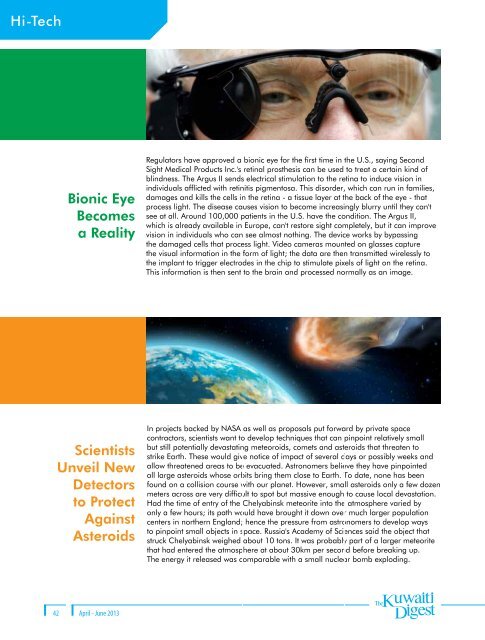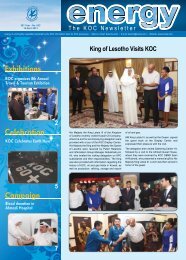6 - Kuwait Oil Company
6 - Kuwait Oil Company
6 - Kuwait Oil Company
Create successful ePaper yourself
Turn your PDF publications into a flip-book with our unique Google optimized e-Paper software.
Hi-Tech<br />
Bionic Eye<br />
Becomes<br />
a Reality<br />
Regulators have approved a bionic eye for the first time in the U.S., saying Second<br />
Sight Medical Products Inc.'s retinal prosthesis can be used to treat a certain kind of<br />
blindness. The Argus II sends electrical stimulation to the retina to induce vision in<br />
individuals afflicted with retinitis pigmentosa. This disorder, which can run in families,<br />
damages and kills the cells in the retina - a tissue layer at the back of the eye - that<br />
process light. The disease causes vision to become increasingly blurry until they can't<br />
see at all. Around 100,000 patients in the U.S. have the condition. The Argus II,<br />
which is already available in Europe, can't restore sight completely, but it can improve<br />
vision in individuals who can see almost nothing. The device works by bypassing<br />
the damaged cells that process light. Video cameras mounted on glasses capture<br />
the visual information in the form of light; the data are then transmitted wirelessly to<br />
the implant to trigger electrodes in the chip to stimulate pixels of light on the retina.<br />
This information is then sent to the brain and processed normally as an image.<br />
Scientists<br />
Unveil New<br />
Detectors<br />
to Protect<br />
Against<br />
Asteroids<br />
In projects backed by NASA as well as proposals put forward by private space<br />
contractors, scientists want to develop techniques that can pinpoint relatively small<br />
but still potentially devastating meteoroids, comets and asteroids that threaten to<br />
strike Earth. These would give notice of impact of several days or possibly weeks and<br />
allow threatened areas to be evacuated. Astronomers believe they have pinpointed<br />
all large asteroids whose orbits bring them close to Earth. To date, none has been<br />
found on a collision course with our planet. However, small asteroids only a few dozen<br />
meters across are very difficult to spot but massive enough to cause local devastation.<br />
Had the time of entry of the Chelyabinsk meteorite into the atmosphere varied by<br />
only a few hours; its path would have brought it down over much larger population<br />
centers in northern England; hence the pressure from astronomers to develop ways<br />
to pinpoint small objects in space. Russia's Academy of Sciences said the object that<br />
struck Chelyabinsk weighed about 10 tons. It was probably part of a larger meteorite<br />
that had entered the atmosphere at about 30km per second before breaking up.<br />
The energy it released was comparable with a small nuclear bomb exploding.<br />
42<br />
April - June 2013

















